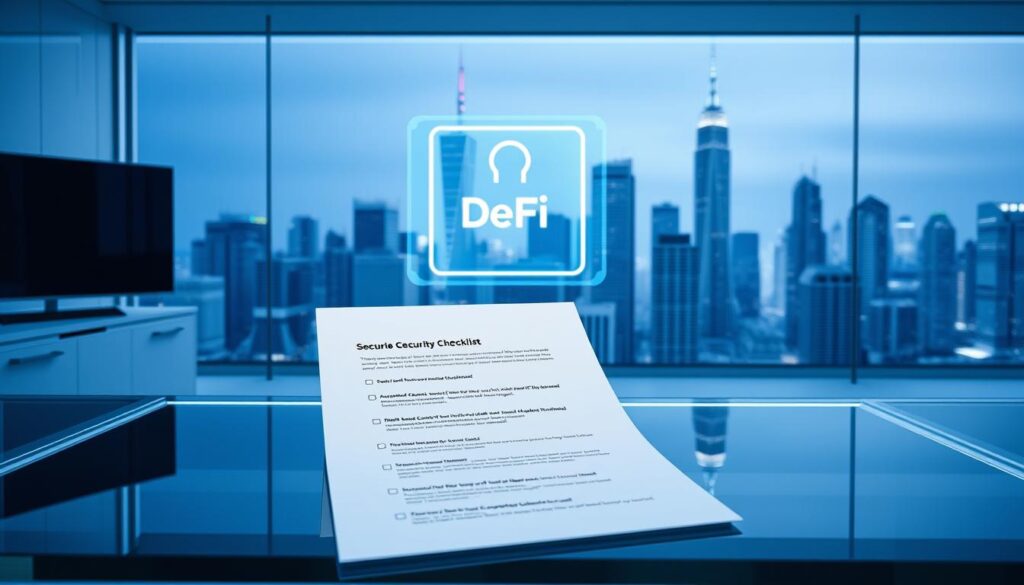The world of finance is evolving fast, and decentralized finance is leading the charge. With over $35 billion staked in Ethereum alone, this space is reshaping how people earn passive income. The shift to Proof-of-Stake networks has unlocked new ways to grow wealth securely.
By 2025, experts predict even stronger security measures and innovative solutions like restaking. This lets your assets work harder by securing multiple blockchain protocols at once. Leading projects already hold over $40 billion in Total Value Locked (TVL), proving trust in this system.
Staking has become a top choice for those looking to earn without constant trading. With enhanced safety features, it’s easier than ever to explore secure DeFi investments. The future of finance is here—and it’s built on transparency and opportunity.
Key Takeaways
- Decentralized finance is transforming traditional investment methods.
- Proof-of-Stake networks enable safer and more efficient earning.
- Restaking innovations allow assets to support multiple protocols.
- Staking is a leading method for generating passive income in crypto.
- Security improvements make DeFi investments more reliable.
What Is DeFi Staking and How Does It Work?
Crypto staking is reshaping how investors grow their digital assets passively. By locking tokens in a blockchain network, you help validate transactions and earn rewards. This process is central to Proof-of-Stake (PoS) systems, where security and efficiency replace energy-heavy mining.
Validators play a key role. They stake large amounts of crypto to verify transactions and create new blocks. If they act dishonestly, slashing penalties destroy part of their stake. This keeps the network secure and trustworthy.
Staking can be custodial (through exchanges) or non-custodial (via DeFi platforms like Lido). With Lido, you stake Ethereum and receive stETH tokens in return. These tokens earn ~3% APR and can be used elsewhere in decentralized finance.
Rewards come from two sources: new tokens minted by the network and a share of transaction fees. Smart contracts automate payouts, ensuring fairness without middlemen.
How does DeFi staking differ from centralized options? Here’s a quick breakdown:
- Ownership: DeFi lets you control your assets; exchanges hold them for you.
- Transparency: All DeFi actions are on-chain, visible to anyone.
- Security: Slashing and audits protect DeFi; centralized platforms rely on internal controls.
- Complexity: DeFi requires more setup but offers greater flexibility.
For example, staking $1000 in Ethereum via Lido could yield ~$30 annually in stETH rewards. It’s a simple way to put idle crypto to work.
Why DeFi Staking Is the Future of Passive Income
Imagine earning 10x more than your bank offers—without lifting a finger. Staking lets your assets work for you, delivering *returns* that leave traditional savings accounts in the dust. With global access and no middlemen, it’s no wonder investors are flocking to this model.
Higher Returns Than Traditional Banking
Banks pay an average of 0.5% interest. In contrast, staking rewards range from 5% to 28%. Projects like Pendle use yield tokenization to boost earnings further. For example, staking $1,000 could net $280 yearly—versus $5 in a bank.
- 10x+ yields: Solana staking via Jito offers 9% APY.
- No gatekeepers: Rewards compound automatically.
Flexibility and Control Over Your Assets
Unlike banks, you own your assets outright. Choose lock-up periods or unstake anytime. Multi-chain support (Ethereum, Solana, Bitcoin) means more opportunities.
Access to Emerging Cryptocurrencies
Staking new tokens like ENA grants early adopter advantages. You earn while supporting innovative projects. This flexibility is reshaping how investors build wealth.
Key Factors to Consider Before Investing in DeFi Platforms
Not all staking opportunities are created equal—some carry hidden risk. Protecting your assets starts with understanding these essential evaluation criteria. A few minutes of research now could save you from costly mistakes later.

Security Measures and Protocol Audits
Always verify third-party audits before committing funds. Projects like EigenLayer use permissionless audits to prove their security. Lido’s $40B TVL demonstrates years of incident-free operation.
Look for these red flags:
- Unaudited smart contracts
- Lack of multi-signature wallets
- No insurance fund for emergencies
Supported Cryptocurrencies and APY Rates
Sustainable rewards matter more than flashy numbers. While some platforms advertise 20%+ APY, check if their revenue model supports those payouts long-term.
Compare these factors:
- Native token vs stablecoin rewards
- Compounding frequency
- Fee structures (often hidden)
Liquidity and Withdrawal Options
Your assets should remain accessible. EtherFi’s eETH maintains 99% ETH peg liquidity—ideal for quick exits. Note withdrawal periods like Babylon’s 21-day Bitcoin unstaking delay.
Ask these questions:
- Can I sell my staked tokens immediately?
- What penalties apply for early unstaking?
- Are there secondary markets for liquidity?
Case Study: Pendle’s vePENDLE system lets token holders vote on risk parameters. This governance layer helps prevent rug-pulls by aligning incentives.
DeFi 2025: Platforms Offering 20% APY Safely
Earning passive income shouldn’t mean compromising on safety—here’s how to do both. We’ve curated seven platforms that balance high rewards with robust security, averaging 18.6% APY. From liquid staking to Bitcoin integrations, each option is vetted for reliability.
Restaking innovations like EigenLayer and EtherFi’s collaboration add extra layers of protection. Your assets secure multiple protocols while earning compounded yields. This model is reshaping trust in decentralized finance.
Explore these diverse sectors:
- Liquid staking: Lido’s stETH tokens offer ~3% APY with Ethereum flexibility.
- Bitcoin staking: Babylon unlocks BTC rewards on PoS chains.
- Stablecoins: Ethena’s USDe yields up to 28% with hedging strategies.
Compare key metrics before investing:
- APY ranges: 5% (Lido) to 28% (Ethena).
- Supported assets: ETH, SOL, BTC, stablecoins.
- Liquidity: Instant unstaking (EtherFi) vs. 21-day delays (Babylon).
Warning: Yields above 30% often signal unsustainable models. Stick to audited platforms with transparent revenue streams. Your security should never be an afterthought.
Lido Finance: Liquid Staking for Ethereum and Beyond
With Lido Finance, your staked assets remain liquid, letting you earn without locking them away. This pioneer in liquid staking holds over $40B in Total Value Locked (TVL), proving its trustworthiness. By converting ETH to stETH, you keep liquidity while earning ~3% staking rewards.
Core Features and Supported Assets
Lido’s magic lies in its tokenized staking. Deposit ETH and receive stETH, which automatically accrues rewards. These tokens work across protocols like Aave or Compound, letting you double-dip—earn staking yields and lending interest.
Supported chains include:
- Ethereum: 3% APR with stETH
- Solana: 5% via stSOL
- Polygon: 4% with stMATIC
- Polkadot: 5% via stDOT
Governance relies on LDO token holders and 150+ node operators. This ensures decentralized decision-making for key upgrades.
Pros and Cons of Staking with Lido
Advantages:
- Deep liquidity: Trade stETH instantly on exchanges
- Multi-chain support: Diversify across networks
- DeFi integrations: Use staked tokens as collateral
Challenges:
- Centralization risks: Node operators are permissioned
- Smart contract exposure: Audited but not risk-free
Real-world example: Stake 1 ETH → get 1 stETH. Deposit stETH on Aave to earn 2% lending APY plus Lido’s 3% staking rewards. Your assets work harder without sitting idle.
Pendle Finance: Yield Tokenization for Advanced Investors
Yield tokenization is revolutionizing how savvy investors maximize returns. Pendle Finance splits staking rewards into tradable assets—letting you sell future earnings or hedge against volatility. With $5B in Total Value Locked, it’s a top choice for those wanting more control.
How Pendle’s Automated Market Maker Works
Traditional AMMs suffer from impermanent loss. Pendle’s design minimizes this by separating assets into two tokens:
- Principal Tokens (PT): Represent your initial deposit
- Yield Tokens (YT): Claim future rewards
This split creates deeper liquidity. You can trade YTs like stocks—betting on or against future yields. For example, selling YTs locks in today’s high APY before rates drop.
| Feature | Pendle | Traditional Staking |
|---|---|---|
| Yield Access | Trade anytime | Locked until unstaking |
| Complexity | Advanced tools | Simple but limited |
| Best For | Active investors | Passive holders |
Staking Rewards and Governance with PENDLE Tokens
Lock PENDLE tokens to get vePENDLE—your key to governance votes and boosted returns. Current top yields include:
- 28% APY on Ethena’s sUSDe
- 18% on Ethereum liquid staking
Note: These protocols use derivatives. They’re powerful but suit experienced users. Always assess risks before trading YTs.
Real-world use case: A trader buys PTs at a discount and shorts YTs—profiting whether yields rise or fall. Pendle turns static staking into dynamic strategies.
EigenLayer: Restaking for Enhanced Security and Rewards
Your staked crypto can do more than just sit idle—EigenLayer proves it. This innovative protocol lets you reuse staked ETH to secure additional blockchain networks. With $20B in Total Value Locked, it’s reshaping how investors maximize their assets.
The Power of Restaking
Traditional staking locks your coins to secure one network. EigenLayer changes this by allowing «restaking»—using the same ETH to back multiple protocols. It’s like getting paid twice for the same security work.
«Restaking creates compounding security value without requiring additional capital lockup.»
Here’s how it works:
- Stake ETH or liquid staking tokens (LSTs) like stETH
- Opt into securing additional services like rollups or oracles
- Earn extra rewards from each secured protocol
Supported Assets and EigenDA Integration
EigenLayer accepts various assets for restaking:
- Native ETH
- Liquid staking tokens (stETH, rETH)
- Select ERC-20 tokens
Its EigenDA service specifically helps reduce costs for rollup networks. By providing decentralized data availability, it makes layer-2 solutions more affordable while generating rewards for restakers.
| Feature | Restaking | Traditional Staking |
|---|---|---|
| Security Scope | Multiple protocols | Single network |
| Reward Sources | 2+ income streams | 1 reward system |
| Risk Profile | Compound slashing | Single network risk |
Security remains paramount—slashing penalties apply across all secured services if you misbehave. This creates stronger incentives for proper validation.
Real-world example: Restaking stETH to secure both EigenLayer and Omni Network could yield 5% from Ethereum plus 3% from Omni. Your assets work harder while maintaining security across ecosystems.
EtherFi: Non-Custodial Staking with Full Control
Control meets rewards in EtherFi’s non-custodial staking solution. Unlike traditional options, you keep ownership of your validator keys while earning 4.3% APY on Ethereum. This approach gives you complete authority over your assets.
Liquid Staking Tokens and EigenLayer Collaboration
EtherFi’s eETH token brings liquidity to staked ETH. You can trade it or use it across protocols while still earning rewards. The magic happens through decentralized node operators who never take custody of your keys.
Integration with EigenLayer adds another layer of opportunity. Your staked ETH helps secure additional networks, compounding your earnings. This restaking feature boosts security across multiple ecosystems simultaneously.
How does EtherFi compare to market leader Lido?
- Lower fees: 0.5% vs Lido’s 10% commission
- Newer ecosystem: Fewer integrations but growing fast
- True self-custody: Validator keys remain under your control
The Operation Solo Staker program empowers home validators. Run your node with just 4 ETH while keeping full ownership. EtherFi handles the complex infrastructure.
Real-world strategy: Stake 4 ETH → receive eETH → deposit in Pendle Finance for yield tokenization. This stacks staking rewards with trading opportunities for amplified liquidity benefits.
While newer than some DeFi staples, EtherFi’s innovative approach makes it a strong contender for control-focused investors. Your assets stay productive without sacrificing access.
Ethena: Stablecoin Staking with High APY
What if your stablecoins could earn 27% without losing their peg? Ethena makes this possible through its synthetic dollar model. With $1.3B locked in, it’s redefining what stablecoin yields can achieve.
The magic happens through a delta-neutral strategy. Your staked ETH collateralizes short ETH futures positions. This creates a dollar-denominated asset (USDe) that pays returns from both staking rewards and futures funding rates.

Traditional stablecoins like USDC can’t match these yields. Here’s why:
| Factor | Ethena (USDe) | Traditional Stablecoins |
|---|---|---|
| APY | Up to 27% | 0-5% |
| Risk | Basis trade fluctuations | Counterparty risk |
| Collateral | Staked ETH + derivatives | Cash equivalents |
Two key risks demand attention. Basis trade slippage can temporarily reduce yields. Custodial dependencies exist for futures positions. These make USDe better suited for experienced investors.
Ethena shines when integrated with DeFi ecosystems. Pendle Finance lets you tokenize USDe yields. Curve pools provide instant liquidity. These options multiply earning potential.
Important: While the 27% APY is tempting, treat USDe as a higher-risk instrument. It’s ideal for those comfortable with derivatives markets and smart contract exposure.
Jito: Solana’s Leading Liquid Staking Solution
Solana’s speed meets staking rewards in Jito’s liquid solution. This platform turns your idle SOL into a productive asset while keeping it liquid. With 9% APY, it outperforms Solana’s base 6.5% rate.
The secret? MEV (Maximal Extractable Value) rewards. Jito redistributes profits from blockchain arbitrage opportunities to stakers. This creates an extra 2.5% yield boost you won’t find elsewhere.
Your staked SOL becomes JitoSOL—a liquid token you can use across Solana’s ecosystem. This maintains liquidity while your assets earn. Swap, lend, or collateralize JitoSOL without unstaking.
Compare Jito to Marinade Finance:
- Higher yields: 9% vs 6.8% (Marinade)
- MEV sharing: Unique to Jito
- Newer protocol: Less track record than Marinade
Advanced strategies multiply earnings. Stake SOL → get JitoSOL → lend on Marginfi for 15%+ APY. The platform integrates seamlessly with Kamino for leveraged yield farming too.
Pro tip: JitoSOL maintains 1:1 peg stability, making it ideal for DeFi operations. Your rewards compound automatically—no manual claiming needed.
Babylon: Bitcoin Staking for PoS Networks
Bitcoin holders now have a groundbreaking way to earn passive income—without selling their coins. Babylon’s protocol lets you stake BTC to secure Proof-of-Stake (PoS) chains like Polygon. Earn 3–5% yields while keeping your Bitcoin intact.
- Time-locked contracts: Your BTC stays in your wallet but commits to securing PoS networks.
- Rewards: Earn in the native token of supported chains (e.g., MATIC for Polygon).
- Unlock period: Withdrawals take 21 days, similar to Ethereum’s staking design.
Current partners include:
- Polygon: Stake BTC to help validate transactions.
- BounceBit: A new chain offering 4% APY for BTC stakers.
Risks to Consider
Cross-chain bridges pose the biggest security risk. If compromised, your BTC could be vulnerable. Babylon mitigates this with:
- Decentralized watchtowers monitoring transactions.
- Slashing penalties for malicious validators.
Traditional CeFi vs. Babylon’s DeFi Approach
| Feature | CeFi (e.g., Celsius) | Babylon |
|---|---|---|
| Custody | You lose control | Non-custodial |
| Yields | 1–3% | 3–5% |
| Security | Exchange risk | Smart contract audits |
Example: Stake 0.5 BTC on BounceBit → earn 4% APY in BB tokens. Your BTC remains untouched, but now works across blockchain ecosystems.
Babylon turns Bitcoin into a multi-chain asset. It’s a leap forward for staking innovation—bridging the gap between PoW and PoS protocols.
Emerging Trends in DeFi Staking for 2025
The next wave of staking innovations is breaking traditional boundaries. By 2025, your assets could secure multiple blockchain networks simultaneously while earning compounded rewards. These advancements make passive income smarter and more efficient.

Permissionless Token Support Expands
EigenLayer’s ERC-20 integration changes the game. Now, virtually any token can participate in staking—not just native coins. This opens doors for smaller projects to leverage existing security.
Key benefits include:
- Broader participation: Investors stake niche tokens without swapping
- Ecosystem growth: New protocols bootstrap security faster
- Flexible yields: Combine rewards from multiple assets
Restaking’s Network Effect
Restaking turns $1 of staked value into $3 of ecosystem security. Projects like EigenLayer prove this multiplier effect works. Your ETH can now secure:
| Service | Additional Yield |
|---|---|
| Data availability layers | +1.5% APY |
| Oracle networks | +0.8% APY |
| Cross-chain bridges | +1.2% APY |
Layer 2 solutions like zkSync now support native staking too. Polygon’s CDK chains will follow, creating more opportunities.
Regulators are watching liquid restaking tokens (LRTs). The SEC may classify them as securities, so stay informed. Despite this, analysts predict 50% of staked ETH will be restaked by 2026.
These trends prove DeFi staking is becoming more versatile. Your assets can work harder across an interconnected web of protocols.
FAQ
What is decentralized finance (DeFi) staking?
DeFi staking lets you earn rewards by locking your crypto assets in a protocol. Unlike traditional banking, it offers higher returns while keeping you in control of your funds.
Why should I consider staking for passive income?
Staking provides better annual percentage yields (APY) than savings accounts. You also get flexibility, access to new cryptocurrencies, and full ownership of your assets.
How do I choose a secure platform for staking?
Look for audited protocols, strong security measures, and transparent APY rates. Check liquidity options and withdrawal terms before committing funds.
Conclusion
Staking has evolved beyond simple rewards—it’s now a gateway to multi-chain security. Leading platforms like Lido and EigenLayer show how your assets can earn passive income while supporting entire ecosystems. With $100B+ expected in staked value, this space is maturing fast.
Always prioritize security when exploring DeFi opportunities. Check audit reports and community governance before committing funds. The best yields come from transparent projects with sustainable models.



